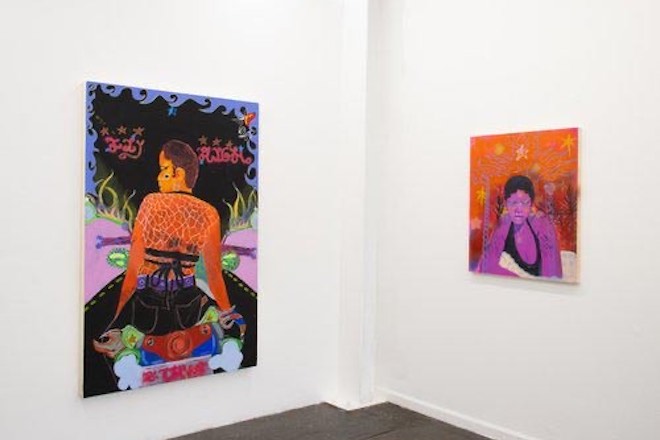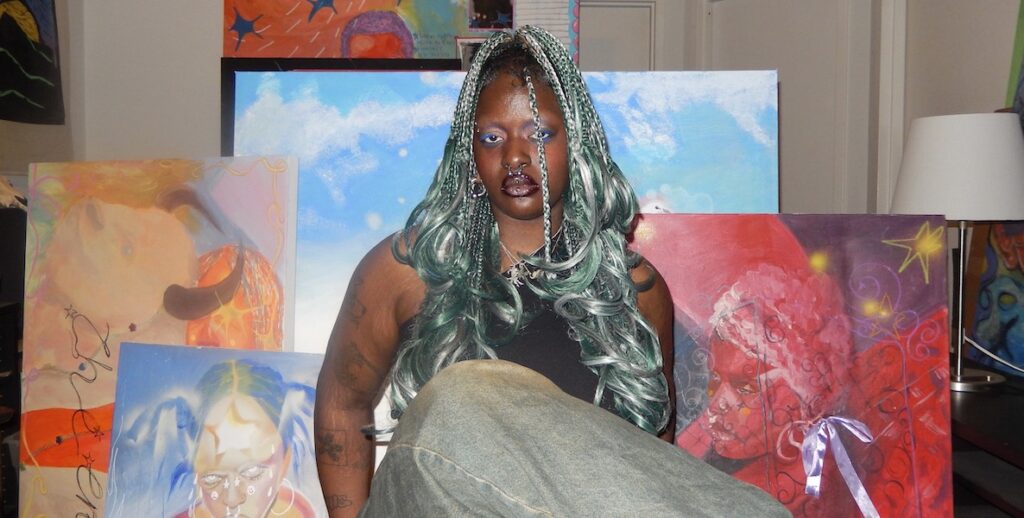Multimedia artist Zeinab Diomande, who graduated from University of the Arts in 2023, is acutely aware of what the city has lost with the sudden closure of the school in May. “I especially think about the low income Black and Brown kids, who just like me were betting on school as ‘the way out,’ whose dreams have been shattered just like that,” they say. “If it weren’t for my professors and the staff, there’s a lot that I would’ve not been able to accomplish in and out of school.”
Diomande’s accomplishments include being a finalist for the AXA Art Prize, exhibiting work in multiple countries and developing a striking art style that uniquely captures Gen Z aesthetics. Fluorescent colors, surreal compositions and bursts of light are bountiful in their paintings, drawings, sculptures and installations. Their mural Dandelion Interlude is currently installed at the Philadelphia International Airport. Followers of Diomande’s Instagram can delightedly scroll through hundreds of their previous works.
At the center of each piece is Diomande themself, who is principled in their approach to making self-portraits. Diomande is intrigued by artists such as Zanele Muholi, Njideka Akunyili-Crosby, Carrie Mae Weems, Renée Cox, who focus almost exclusively on self-portraiture. According to Diomande, artists who are self-portraitists are able “to choose themselves as a narrator that speaks on larger issues and larger ideas.” For Black women, self-representation is infrequent, especially in the world of painting.
Between their youthful self-portraiture and trendy aesthetics, Diomande is aware that their work will feel different in 20 years than it does today. However, they are always considering the future. “I know my work is of my time,” they say, “but I want it to be a time that people are going to remember down the line.”
As part of a partnership with Forman Arts Initiative, the Citizen caught up with Diomande. The interview has been condensed and edited for clarity.

What brought you to University of the Arts?
I moved to Philly seven years ago. Before that I was in the Ivory Coast. I was looking for art schools around the city and I found UArts and they gave me a good scholarship. I took a gap year before starting school so I could save up and have everything figured out. I feel like taking that gap year was very beneficial for me because I had just moved to Philly and I was like, I don’t really know the city.
My first year, I didn’t know anyone. I was just all by myself all the time. I had no friends. It was really, really hard. And then by being in school, immersing myself in the Philly art scene and going to other people’s shows, I started getting a better sense of what the art here was like and what people were into.
How has digital media influenced your work?
Being 14 on Tumblr, I feel like the digital has played a huge part in my work and in my life in general, finding refuge in online spaces and finding community in those more digital worlds. The very vibrant colors and other Gen Z things like that resonate with me a lot. I’m so young and it just makes sense for me to work within my time instead of looking at the past, because I do not know the past.
Do you have any anxieties around digital technologies?
AI really scares me in a lot of ways because I feel like it’s starting to take so much space in the art world now. You get emails like, “Oh, I’m an NFT collector. Can I buy your work as an NFT?” I’m like, Hell no. You’re not going to do that. You’re buying a physical piece or nothing. But it’s scary times in a way. There’s a lot of beauty in the digital, but it’s very precarious. So, that’s something that I always wonder about.
When I make my decisions in terms of my work, I try to be conscious of that. I’m like, Okay, I’m in this age where everything is digital, everything is computerized. Where do I fit in that as someone who works very traditionally?
Your painting surfaces have a lot of texture, what draws you to tactile artwork?
I was working primarily with graphite and things like oil pastel at first. Oil pastel was more like a test when I started. I wanted to know more about other materials and how that could affect texture. And then as I progressed, I was just more interested in how I can push that even further. How can the work feel more sculptural in some ways? How can the work feel almost 3D while still being in a very 2D form? I feel like I’m in a place where I would love to push that even more and maybe make the work even come more out of the picture plane.
What materials have you been experimenting with to achieve more texture?
I’ve been mixing paint with baking soda. It makes this very thick paint. It’s almost like using paint mediums but it’s cheaper and it works very well. When it dries, it has a rock solid texture. It almost feels like you’re sculpting onto canvas. So, that’s really interesting.
How quickly do you create your paintings?
I generally start with a figure, which is the part that’s more slow. But the background is more symbolic and the mark-making is quicker and more all over the place. I never start multiple paintings at once. I always focus on one. So, I could be sitting for eight, nine hours on one painting, with tunnel vision. I’m like, I’m finishing this today. It’s not the healthiest, but it works for me.
How did you get introduced to painting?
It’s funny because I didn’t even start painting until 2021. For the longest, I used to make pastel drawings. I feel like I was scared of the idea of painting. I was like: I’m very good at drawing and I want to stay there. But then I was like: You cannot stay there. It’s not going to make you grow to not challenge yourself.
My earlier paintings were nowhere near where they are today. But I still enjoyed them. I feel like the work was very naive and there were a lot of things that I didn’t know. There was so much beauty in that and it was very freeing. Now I’m more conscious of the decisions that I make when I paint because I have more knowledge. I feel like there’s also beauty in gradually teaching myself how to improve my technique and improve the composition.
Have you received any particularly good advice that you keep coming back to?
I had [painter] Patricia Renee’ Thomas as my professor. Really, really inspiring person. She always said, “You need to keep exploring. This is something that you need to keep doing because that’s the beauty of your work, you’re always trying out new things.” So, that’s something that I’m trying to carry with me. Whatever point I get to in terms of my work, the exploration is always going to be something that I’m going to do because I feel like you can never stop learning. There’s always something to improve or something to try. I feel like a lot of artists, whenever they solidify what their style is, they just get stuck in that loop. That’s not a position that I want to be in.
Do you consider what collectors think of your work?
I have actually, and the interesting thing is that the collectors who I’ve been working with are more open to the paintings where I felt like I’ve been exploring more, where I’ve been branching out or trying things that I wouldn’t normally try. Those are the kind of people that I want to keep working with because I don’t want the people who want only one type of painting to try to define how I should be working.
Do you think a lot about your goals as an artist thinking 20 or 30 years down the line?
This is something that I think about a lot, especially when I’m working. I’m thinking about the fact that now is the time to lay the foundations for the work to last, because I love projecting myself in the future. I ask myself: Is the work still going to make sense 20, 30, 50 years from now? Every time I make a decision in my work, I’m like, Is this going to hold any relevance in the future? Is this going to be something that people are going to remember? I don’t want to be a spur of the moment artist.
What ideas in your work do you think will be the most relevant in the future?
The idea of taking a space and being a Black woman who just does self-portraiture is not something that used to be done. It was done in photography and things like that, but in painting you didn’t really have a lot of Black women from coming forward and being like, I’m just going to paint myself. I feel like in a more contemporary world, you’re starting to see that more and more.
In terms of the future, that’s something that I hope we keep developing.
How do you abstract the Black body? My friend Kwamé Azure Gomez is someone that’s already doing that, using things like combs, and braiding hair to make marks on a canvas, which I always find so fascinating. There’s so many ways to translate those ideas. And I would love to see how people go about them, myself included.
Do you plan to teach one day?
I am definitely going to teach. There’s so many mistakes that I’ve made as an artist that I would love to warn people about. For example, signing a three year contract when I was 21-years-old or thinking that if I didn’t fit into whatever trends the art world had set, that I was never going to make it anywhere. Not prioritizing rest. I would never want my future students to put themselves through this, let alone feeling like they have to. I want to pass down the things that I know.
Something I don’t like doing is gatekeeping. I feel like teaching is the best way to have other people know the things that I know and maybe even more. I want to have their perspective on certain things, because like I said, you never stop learning.
Logan Cryer is a curator based in Philadelphia with a penchant for local art histories. They currently serve as the Co-Curator of Icebox Project Space and they like to rewatch documentaries.
This story is part of a partnership between The Philadelphia Citizen and Forman Arts Initiative to highlight creatives in every neighborhood in Philadelphia. It will run on both The Citizen and FAI’s websites.

